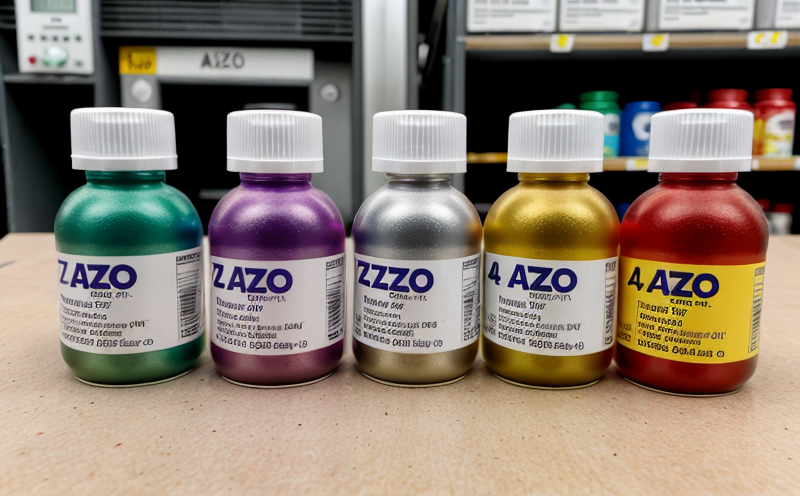Determination of restricted disperse dyes in polyester
In the textile industry, ensuring product compliance with regulatory standards and consumer safety is paramount. One critical aspect of this involves identifying and quantifying restricted disperse dyes within polyester fabrics, which are widely used in clothing, home textiles, and industrial products. This service focuses on determining the presence and concentration levels of these regulated substances to ensure that textile products meet international quality and environmental standards.
The identification of restricted disperse dyes is particularly important because some disperse dyes can migrate from the polyester fiber during wear or washing, potentially leading to adverse health effects if ingested. Regulatory bodies like the European Union (EU) have established lists of prohibited substances that must not be present in textile products sold within their jurisdiction. These restrictions are outlined in directives such as REACH and Oeko-Tex Standard 100.
Our laboratory employs advanced analytical techniques to detect these restricted disperse dyes with precision and accuracy. The methodology typically involves the following steps:
- Sample Preparation: Samples of polyester textiles are cut into standard-sized pieces, ensuring that they are representative of the entire product.
- Solvent Extraction: The samples undergo solvent extraction to release any disperse dyes present. This step is critical for accurately quantifying the dye content.
- High-Performance Liquid Chromatography (HPLC) Analysis: Once extracted, the samples are analyzed using HPLC equipped with appropriate detectors such as UV/Vis or mass spectrometry to identify and quantify specific disperse dyes.
- Data Interpretation: The results from the HPLC analysis are interpreted against established regulatory limits for restricted substances. This ensures compliance with local and international standards.
The testing process is meticulous, involving multiple quality checks at each step to ensure accuracy and reliability of results. Our expertise lies in providing comprehensive reports that detail not only the concentration levels but also the specific types of disperse dyes detected. This information is invaluable for manufacturers looking to improve product safety and maintain a competitive edge in the global market.
By offering this service, we aim to support our clients in meeting stringent regulatory requirements and enhancing their reputation as leaders in responsible manufacturing. Our commitment to accuracy and quality ensures that every test conducted contributes to safer products and sustainable practices within the textile industry.
Benefits
Compliance with international standards is crucial for any business operating in a global market, especially when it comes to textiles. Our determination of restricted disperse dyes service offers several key benefits:
- Enhanced Compliance: Ensures that your products meet the stringent requirements set by regulatory bodies like REACH and Oeko-Tex Standard 100.
- Risk Mitigation: By identifying restricted disperse dyes early in the production process, you can mitigate risks associated with non-compliance penalties or recalls.
- Improved Product Safety: Consumers trust brands that prioritize safety. Demonstrating compliance to these standards enhances consumer confidence and loyalty.
- Competitive Advantage: Leading-edge testing services position your company as a leader in responsible manufacturing, appealing to eco-conscious consumers.
- Avoidance of Legal Issues: Non-compliance can lead to legal actions and reputational damage. Our service helps you stay ahead of potential issues.
- Customer Satisfaction: Providing products that meet the highest quality standards leads to increased customer satisfaction, which is essential for long-term business success.
In summary, this service not only helps your organization avoid legal and reputational risks but also enhances your reputation as a responsible and forward-thinking company in the textile industry.
Customer Impact and Satisfaction
- Increased Product Quality: By identifying restricted disperse dyes early in the production process, customers can ensure that their products meet the highest quality standards.
- Enhanced Reputation: Compliance with international standards enhances a company's reputation as a responsible and trustworthy manufacturer.
- Reduced Risk of Non-Compliance Penalties: Regular testing helps prevent costly legal actions and reputational damage associated with non-compliance.
- Improved Consumer Confidence: Products that meet stringent quality standards are more likely to gain consumer trust, leading to increased customer satisfaction and loyalty.
- Achievement of Sustainability Goals: By ensuring compliance with environmental regulations, companies contribute to sustainable practices within the textile industry.
Our clients consistently report higher levels of customer satisfaction and enhanced product quality following our testing services. These outcomes are a direct reflection of our commitment to providing accurate and reliable results that meet the highest standards in the industry.
Use Cases and Application Examples
The determination of restricted disperse dyes is applicable across various sectors within the textile industry, including clothing manufacturers, home furnishing companies, and industrial fabric producers. Here are some specific use cases:
- Clothing Manufacturers: Ensuring that garments comply with REACH and Oeko-Tex standards helps protect consumers from potential health risks.
- Home Furnishings: Upholstery and interior textiles must meet strict safety regulations to ensure they are safe for household use.
- Industrial Fabrics: Textiles used in construction, automotive, and medical industries require rigorous testing to guarantee durability and safety.
In each of these sectors, the detection of restricted disperse dyes is critical for maintaining product integrity and compliance with international standards. Our laboratory provides a reliable service that supports these industries in meeting their regulatory obligations.





